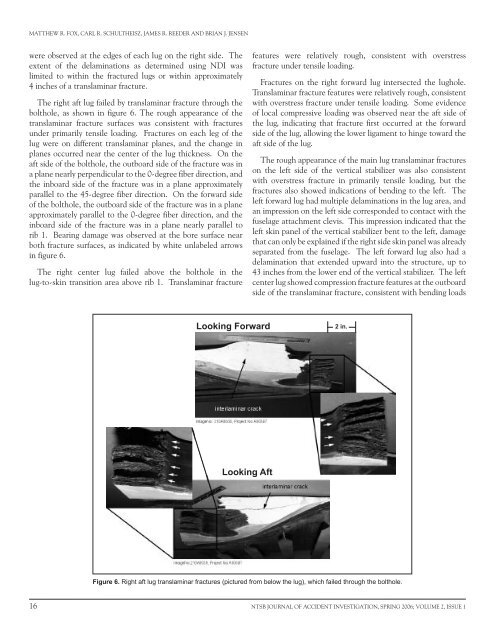Journal of Accident Investigation
Journal of Accident Investigation
Journal of Accident Investigation
You also want an ePaper? Increase the reach of your titles
YUMPU automatically turns print PDFs into web optimized ePapers that Google loves.
MATTHEW R. FOX, CARL R. SCHULTHEISZ, JAMES R. REEDER AND BRIAN J. JENSEN<br />
were observed at the edges <strong>of</strong> each lug on the right side. The<br />
extent <strong>of</strong> the delaminations as determined using NDI was<br />
limited to within the fractured lugs or within approximately<br />
4 inches <strong>of</strong> a translaminar fracture.<br />
The right aft lug failed by translaminar fracture through the<br />
bolthole, as shown in figure 6. The rough appearance <strong>of</strong> the<br />
translaminar fracture surfaces was consistent with fractures<br />
under primarily tensile loading. Fractures on each leg <strong>of</strong> the<br />
lug were on different translaminar planes, and the change in<br />
planes occurred near the center <strong>of</strong> the lug thickness. On the<br />
aft side <strong>of</strong> the bolthole, the outboard side <strong>of</strong> the fracture was in<br />
a plane nearly perpendicular to the 0-degree fiber direction, and<br />
the inboard side <strong>of</strong> the fracture was in a plane approximately<br />
parallel to the 4 -degree fiber direction. On the forward side<br />
<strong>of</strong> the bolthole, the outboard side <strong>of</strong> the fracture was in a plane<br />
approximately parallel to the 0-degree fiber direction, and the<br />
inboard side <strong>of</strong> the fracture was in a plane nearly parallel to<br />
rib 1. Bearing damage was observed at the bore surface near<br />
both fracture surfaces, as indicated by white unlabeled arrows<br />
in figure 6.<br />
The right center lug failed above the bolthole in the<br />
lug-to-skin transition area above rib 1. Translaminar fracture<br />
features were relatively rough, consistent with overstress<br />
fracture under tensile loading.<br />
Fractures on the right forward lug intersected the lughole.<br />
Translaminar fracture features were relatively rough, consistent<br />
with overstress fracture under tensile loading. Some evidence<br />
<strong>of</strong> local compressive loading was observed near the aft side <strong>of</strong><br />
the lug, indicating that fracture first occurred at the forward<br />
side <strong>of</strong> the lug, allowing the lower ligament to hinge toward the<br />
aft side <strong>of</strong> the lug.<br />
The rough appearance <strong>of</strong> the main lug translaminar fractures<br />
on the left side <strong>of</strong> the vertical stabilizer was also consistent<br />
with overstress fracture in primarily tensile loading, but the<br />
fractures also showed indications <strong>of</strong> bending to the left. The<br />
left forward lug had multiple delaminations in the lug area, and<br />
an impression on the left side corresponded to contact with the<br />
fuselage attachment clevis. This impression indicated that the<br />
left skin panel <strong>of</strong> the vertical stabilizer bent to the left, damage<br />
that can only be explained if the right side skin panel was already<br />
separated from the fuselage. The left forward lug also had a<br />
delamination that extended upward into the structure, up to<br />
43 inches from the lower end <strong>of</strong> the vertical stabilizer. The left<br />
center lug showed compression fracture features at the outboard<br />
side <strong>of</strong> the translaminar fracture, consistent with bending loads<br />
Looking Forward 2 in.<br />
Looking Aft<br />
Figure 6. Right aft lug translaminar fractures (pictured from below the lug), which failed through the bolthole.<br />
16 NTSB JOURNAL OF ACCIDENT INVESTIGATION, SPRING 2006; VOLUME 2, ISSUE 1
















